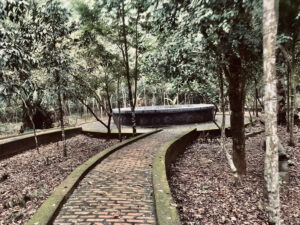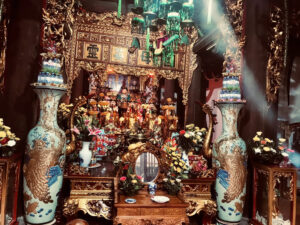Thung Lá (La Valley) is the sister village to nearby Thung Lau. In a deep valley of around 4 km² sounded by five mountains,Thung La is less than a kilometer or so away from its more famous cousin. But while Thung Lau celebrates King Dinh Bo Linh and his famous healer, Saint Nguyen Minh Khong, Thung La is all about Quốc Mẫu (the Mother goddess of Vietnam), Dinh Bo Linh’s actual mother Đàm thị and the legendary (female) mystic Vương Bà.
Its location was once a tightly held secret, not just for its spiritual qualities but also for its strategic important as a hidden stronghold of the Dinh Dynasty forces. These days however, Thung La is far from hidden and is regularly inundated with pilgrims wishing to worship and pay respect to the Mother goddess and the legendary Vuong Ba.
Vuong Ba
Legends recount Vuong Ba as a gifted fortune teller and healer who King Dinh Bo Linh often consulted before battle for auspicious omens. On his return from battle, Thung La was where he took the sick and wounded for treatment. While Vuong Ba remains somewhat as a mystery figure in Vietnam history, her help, knowledge and good works were eventual recognized and she was elevated to godhood as a revered ancestor.
By all accounts, Thung La could be considered the feminine version of Thung Lau, the pair a sort of yin/yang of holy sites. Originally the valley only contained a stone alter to the Mother goddess (Quốc Mẫu) but over the centuries this was expanded to a full temple including worship and celebration of the first King’s mother and of Vuong Ba herself.
The temple has the typical Chau/Quan architecture, a stylized physical representation of the Han characters of the same name. The three “houses” of the temple all have the “triple gate” entry typical of Vietnamese spiritual architecture of the time and at the very top a pair dragons worshiping the moon.
Architecture
The courtyard of Thung La is spacious and airy, surrounded by trees and flowers native to the Gia Vien area. As water is considered a positive element in feng shui that brings luck to the owner, the temple grounds are bordered by a tiny artificial canal painted with a green-red dragon signifying prosperity. According to the Bagua sign, to increase the prosperity of the temple there are little paths built to surround and focus on the well and express the holiness of this sacred location where “gods live”.
The shrine itself is the temple’s main spiritual area. Inside is the altar, with the uppermost tier honoring the three Mother Goddesses of Tứ Phủ (aka Four Palaces).
Note: A trait of Tu Phu is that the Thiên phủ (Heaven Palace) is ruled by the Mother Goddess of Heaven (Mẫu Thượng Thiên), considered beyond the reach of mere mortals and worshiped via the Mother Goddess of Earth (Mẫu Địa Phủ). Hence it is usual in such temples that only 3 of the “High Goddesses” are represented in physical form.
Đạo Mẫu
On the center altar is also a statue of Vương Bà wearing a blue costume and in the last row is a statue of Five Venerable Commanders ( Ngũ Vị Tôn Quan). The altar statue of the Local Courtier of the Shrine (Chầu Bà Bản Đền Bản Cảnh) and her servant is on the left, and the altar of the Holy Princes (Thánh Hoàng) is on the right, all of them gods in the Four Palaces of Vietnam’s Folk Beliefs of Đạo Mẫu.
Made an “official” Vietnamese Folk Religion in 1987, Dao Mau is believed to enhance the role of women in Vietnamese society and was recognized by UNESCO in 2016 by inclusion in the Representative List of the Intangible Cultural Heritage of Humanity .
Even for skeptics, the surrounding scenery is alone worth the visit, a peaceful lush area abounding in rare medicinal herbs and a cool refreshing air to encourage contemplation of the history and legends of this remarkable country.
Travel TIps
Thung Lau and Thung La hold a shared festival on the 8th day of the 10th Lunar month (around September-October). While smaller than the Spring Festival of Truong Yen at Hoa Lu Ancient City, it is never the less an important date in both the local and national calendar. Besides the normal festivities, games and worship, a unique feature is the procession of women burning incense sticks from the King’s mother and the Mother goddess that winds its way on foot from Thung La to Thung Lau.
The directions to Thung La are much the same as to Thung Lau. First make your way to the marina of the Van Long nature reserve then turn left and continue straight on the long Van Long dike concourse until you see the large sign for Thung Lau on the right. Once you get there, there is a further signpost for Thung La.
Admission is free, but parking tickets for motorbikes will be 5000-10000 VND/per motorbike and 40000-50000/ per car. As this is a sacred place, visitors should dress neatly appropriately. Donations are received graciously, as support for the upkeep but also as a prayer for good luck. We hope you have an amazing experience when visiting this attraction.



